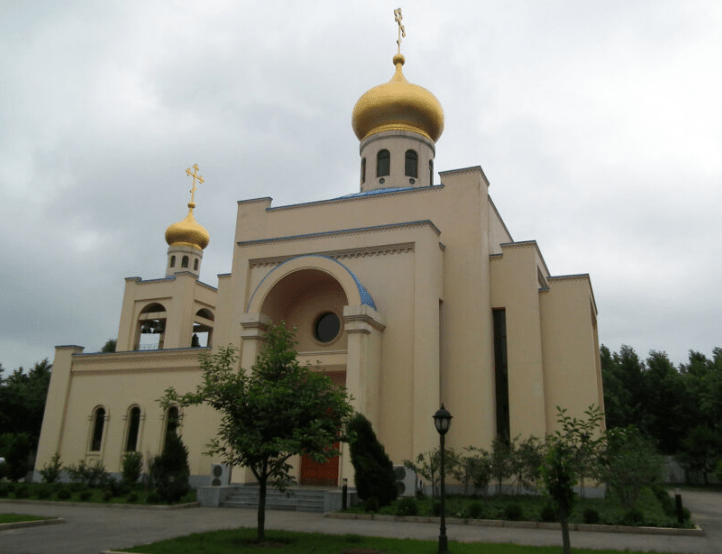
BY : Katherine Kelaidis Christian Today
Earlier this month, Vladimir Putin visited North Korea in search of friends and influence. The visit set off alarm bells around the world, particularly in South Korea and Japan, where the danger of deepening military ties between Russia and North Korea is most acutely felt. The visit was a reminder that Putin’s vision of the “Russian world” extends far beyond the Slavic lands of Eastern Europe.
One aspect of Putin’s visit, however, flew under the radar.
When he was in North Korea, Putin stopped by the Church of the Life-Giving Trinity, where divine offices were held in his honor. He is one of the few to worship there, as, predictably, very few locals do. It was a piece of political theater from the old Soviet days, with the complete cooperation of the Patriarch of Moscow.
Why do Putin and the Patriarch of Moscow care about this tiny congregation?
It might not make sense that anyone, particularly the Russian president and the head of the Russian Orthodox Church, would care about a tiny congregation, locked inside an isolated Stalinist state. But to think this is to ignore the huge importance that the Russian Orthodox Church has as an instrument of Russian soft power around the world.
While many are dismayed at the Orthodox Patriarch Kirill’s refusal to condemn nearly any aspect of Putin’s political project, the truth is that this line of behavior from Kirill has been nothing short of inevitable since becoming primate in 2009. From the beginning, he and Putin forged an alliance that tied the ascendancy of the Russian state to its church and vice versa. The Church of the Life-Giving Trinity, founded before Patriarch Kirill’s episcopacy, has now become part of this partnership.
To understand the importance of Putin’s visit, it helps to learn a bit of history.
Orthodox Christianity in the Korean peninsula began in the last days of imperial Russia. In 1900, at the behest of the Russian state, a small group of clerics became the first Russian Orthodox missionaries to enter Korea.
For 20 years Russia nurtured a small Orthodox community in Korea. But following the Russian Revolution, the besieged Holy Synod of the Moscow Patriarchate terminated its support of the Orthodox Church of Korea. It is a testament to the faith of the small group of converts, whatever the initial reasons for seeking them out, that following the Holy Synod’s decision, Orthodox Christians in Korea remained without any outside support or canonical structures through the entire brutal period of the Japanese occupation and the Korean War.
Then, in 1953, an army chaplain with the Greek forces sent to fight on the peninsula became aware of Korea’s small Orthodox Christian community and offered to help reestablish a parish in Seoul. By the next year, the Metropolis of Korea was a part of the Ecumenical Patriarchate of Constantinople.
No one questioned this status quo, until Kim Jong il, the second supreme leader of North Korea, visited Russia in 2002. Upon his return, he ordered the establishment of the Korean Orthodox Committee, the apparatus through which sanctioned religious bodies operate in North Korea. The next year four seminarians were sent to Moscow to study. In 2006, the Church of the Life-Giving Trinity was consecrated, with members of the Russian church present.
For nearly 22 years, the Church of the Life-Giving Trinity, in Rangrang District in Pyongyang, has served as the country’s only Orthodox church — and one of the few Christian churches in the country.
Meanwhile, in South Korea, the Metropolis of Korea had become a kind of success story of what Orthodox Christianity might look like outside its traditional lands. While the head of the church was an ethnic Greek, most of the clergy and the faithful were Koreans. Expat Greeks, Russians and Romanians worshipped together in a way that is largely out of reach in North America and Western Europe. And for the most part, Russia seemed content to allow the Patriarch of Constantinople to keep the south as it ran the strange church in the north.
That was until 2019, when the Patriarch of Constantinople granted independence to the Ukrainian Orthodox Church. It is hard for those outside to understand fully the implications of what followed, as an incensed Patriarchate of Moscow now had plausible deniability to move into territories like South Korea, Africa and parts of Western Europe, where Constantinople had long held power. The Patriarchate of Moscow quickly established its own diocese in South Korea, threatening the unity of Orthodox Christianity in the peninsula.
Despite predictable protests, the Patriarchate of Moscow’s decision to establish its own churches in South Korea was a geopolitical move, an action on behalf of the Russian state. Abroad the Putin-Kirill alliance is most visible through the Russian Orthodox Church’s missionary efforts. Converts to Russian Orthodoxy are seen to be allies of the Russian state’s agenda. South Korea, Asia’s most Christian nation and a strategic Western ally, is too rich a prize to pass up.
And what about North Korea? Why did Putin visit the Church of the Life-Giving Trinity? The answer is as simple as the deal he has struck with Kirill. The presence of a Russian Orthodox Church in Pyongyang is meant to send a powerful message about Russia’s sphere of influence. This influence is not just economic or martial, but cultural as well. For a man like Vladimir Putin, just as for his friend, Kirill, the mission is not just about power, but a particular kind of power — one that restores the perceived lost dignity of Russia. As Putin prayed in the wall of a church built by one of the world’s last remaining Stalinist dictatorships, he was sending a message about how far and deep Russian influence can go. A message not just for the people of Russia or North Korea, but for the whole world.
© Religion News Service
Photo: Alkhimov Maxim/Wikipedia/Creative Commons



















